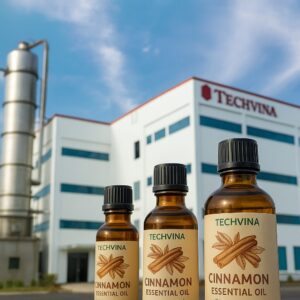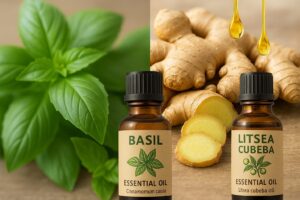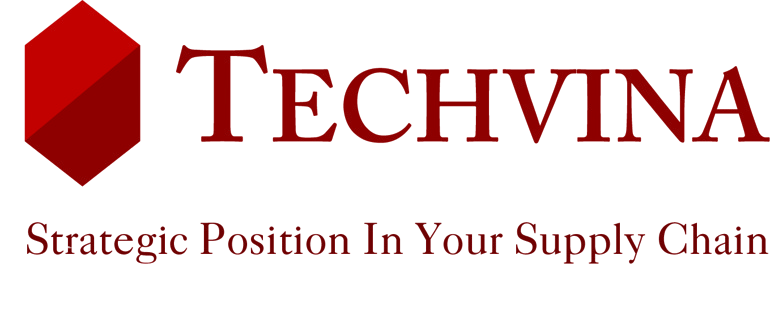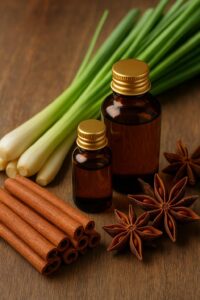1. Organic Essential Oils & the Clean Beauty Wave
In today’s cosmetics world, “clean beauty” transcends a trend—it’s a movement. Consumers in Europe and overseas increasingly demand transparency, sustainability, and safety. According to CAGR, the European organic essential oil market was $3.2 billion in 2024 and is projected to reach $6.5 billion by 2033.
Organic essential oils, certified by bodies like USDA and EU Organic, are essential to meet these standards. Their appeal? Minimal chemical residues, traceable farm‑to‑bottle origins, and suitability with EU regulations (REACH, Cosmetic Regulation 1223).
2. Why Vietnam Shines in the Essential Oil Industry
2.1 Market Growth & Scale
Vietnam is emerging as a key player.According to IMARC reports the industry was valued at USD 70.6 million in 2024 and is projected to hit USD 100.5 million by 2033 (CAGR 7.8%).
2.2 Superior Quality & Purity
Vietnamese cinnamon essential oil (Cassia/Cinnamomum loureiroi) is prized for its high cinnamaldehyde content up to 80% making it ideal for cosmetics and fragrance blends. Techvina uses steam distillation combined with modern extraction tech, holding certifications like USDA Organic, EU Organic, ISO, GMP, FSSC 22000, Halaal, Kosher & FDA.
2.3 Reliable & Sustainable Supply
According to data of Volza’s Global Import data, roughly 490 Vietnamese exporters shipped over 5,000 essential oil loads in 2023‑2024 a remarkable 133% year-over-year rise. The US imports ~64% of Vietnamese essential oils, followed by Germany (~9.1%) and Belgium (~5%). With climate-suited cultivation and rigorous farm‑to‑bottle traceability, supply is dependable.
3. Key Vietnamese Essential Oils for Cosmetics
3.1 Cinnamon (Cassia) Essential Oil
Vietnamese cassia essential oil (Cinnamomum cassia) is known for its warm, spicy, slightly sweet fragrance. Techvina has refined its processing since 2010 to ensure high quality through honesty, traceability, and scientific control. COA and GC tests consistently show cinnamic aldehyde content up to ~80–90%, making it exceptionally potent and pure.
>>> Related article: A STORY OF HONESTY IN THE NATURAL CHEMICAL PRODUCTS INDUSTRY
Cosmetic Uses:
- Toners & serums: Actively supports anti-aging by stimulating microcirculation and firming skin.
- Anti-acne & blemish treatments: Natural antimicrobial properties offer gentle yet effective disinfection .
Other Applications:
- Perfumery: Provides a warm, comforting base note.
- Oral care: Frequently used in mouthwashes and toothpaste for its antibacterial activity.
- Cleaning agents: Acts as a natural disinfectant in eco-friendly formulations.

3.2 Lemongrass Essential Oil
Extracted from Cymbopogon flexuosus or citratus, Vietnamese lemongrass oil boasts 70–80% citral, delivering a fresh citrus aroma well-loved in both cosmetics and aromatherapy.
Formulation Benefits:
- Facial toners & mists: Helps tone skin and refine pores.
- Deodorants & body sprays: Offers natural freshness and odor defense.
- Anti-acne formulations: Citral’s strong antimicrobial effect disrupts biofilms of S. aureus and Candida spp. in vitro.
Cosmetic Benefit Summary:
- Controls excess oil
- Supports acne treatment
- Offers antibacterial, antifungal, and anti-inflammatory properties
3.3 Star Anise Essential Oil
Distinctives:
Derived from Illicium verum, star anise oil yields a sweet, licorice-like scent and is rich in shikimic acid—the raw material for antiviral drugs like oseltamivir. This makes it valuable in both fragrance formulations and wellness skincare .
Cosmetic Applications:
- Fragrance blends: Adds depth and warmth to perfumes.
- Wellness products: Common in aromatherapy for immune support and respiratory health.
- Antiviral sprays & balms: Integrated into germ-fighting personal care items
3.4 Basil & Other Niche Oils (Litsea Cubeba, Ginger, etc.)
Basil Essential Oil:
Contains high levels of linalool, making it refreshing, uplifting, and often included in energy-boosting blends or natural insect-repellent spa products.
Litsea Cubeba & Ginger Oils:
Vietnamese Litsea cubeba gives bright lemony freshness with antimicrobial benefits, while ginger oil offers deep spicy warmth—both popular in premium aromatherapy and luxury skincare lines.

4. Why Cosmetic Brands Choose Vietnam
4.1 Cost‑Effectiveness
Vietnam offers significant cost advantages for international cosmetic brands. The combination of Abundant local raw materials (cassia, lemongrass, star anise, basil…), Low labor costs, Favorable agricultural climate results in lower production costs compared to Europe or North America, without sacrificing quality.
According to a report by Maximize Market Research, essential oil extraction and certification in Vietnam is ~35–50% cheaper than in Germany or the US, particularly for cinnamon and lemongrass derivatives . This cost edge allows cosmetic brands to either improve profit margins or offer competitively priced clean beauty products.
4.2 Consistency & Volume
Vietnam’s essential oil sector is well-established, supported by:
- Long-term cultivation zones in Yen Bai, Quang Nam, Tien Giang, and Tay Bac
- Proven extraction expertise, especially steam distillation
- Export-grade packaging & logistics partnerships
Techvina, for example, maintains multi-ton production capacity monthly for cinnamon oil and aroma isolates, supporting:
- OEM/ODM services (full product manufacturing)
- Private label packaging for international clients
- Contract manufacturing for consistent bulk supply
Global brands benefit from predictable lead times, clear MOQ, and stable annual contracts.
4.3 Certifications & Transparency
Certifications and documentation play a pivotal role in import/export compliance—especially for cosmetic products in the EU and North America.
Techvina demonstrates global transparency standards, offering:
- USDA Organic & EU Organic certifications
- ISO, FSSC 22000, Halal, Kosher, and FDA registrations
- COA (Certificate of Analysis) and MSDS (Material Safety Data Sheets) with every batch
- GC-MS analysis for molecular traceability
- Farm-to-bottle traceability, showing exactly where each batch is sourced
This approach not only facilitates regulatory clearance but also builds trust with brands and end-consumers seeking clean-label, certified formulations.
4.4 Aroma Chemicals & Customization
In addition to bulk essential oils, Techvina is a leading Vietnamese producer of aroma chemicals—natural and semi-synthetic isolates used in cosmetics, perfumes, and personal care.
Their portfolio includes:
- Cinnamic aldehyde (CAS 104-55-2): Warm, spicy fragrance base
- Benzaldehyde (CAS 100-52-7): Almond-like aroma, used in perfumery
- Coumarin & Cinnamyl alcohol: Popular in fragrance layering
What makes Techvina stand out is their ability to tailor aroma profiles based on client briefs:
- Natural isolates for “green” perfumes
- Custom scent blending for niche skincare lines
- Formulation support for clean-label product development
Clients can choose custom ratios, packaging types, and documentation packages ensuring compliance and brand alignment.
5. How to Select a Vietnamese Essential Oil Supplier
5.1 Key Evaluation Criteria
- Certified organic status (USDA/EU).
- COA and GC‑MS reports confirming purity (cinnamaldehyde, citral, linalool).
- Clear supply chain transparency (farm traceability).
5.2 Notable Suppliers
- Techvina – Cinnamon, basil, star anise, organic-certified, aroma chemicals
- Others: VnatureVietnam, ShaviVietnam – certified coconut and cinnamon oil producers.
5.3 Cooperation Workflow
- Request and test product samples (GC‑MS).
- Sign quality agreements + NDA.
- Audit supplier; issue COA / MSDS.
- Place orders with private-label options and shipping (air/sea).
5.4 Questions Buyers Should Ask
- Do you hold USDA/EU Organic certifications?
- Can you provide GC‑MS and batch COA?
- Is production traceable to origin farms?
- What are your MOQ and private label capabilities?
>> Techvina’s blog offers a guide: “10 Crucial Questions to Ask Your Essential Oil Supplier in Vietnam”
6. Conclusion
Vietnamese organic essential oils—particularly cinnamon, lemongrass, and star anise—deliver high purity, cost-effectiveness, traceability, and global certifications. These factors align perfectly with “clean beauty” demands in Europe and internationally.

